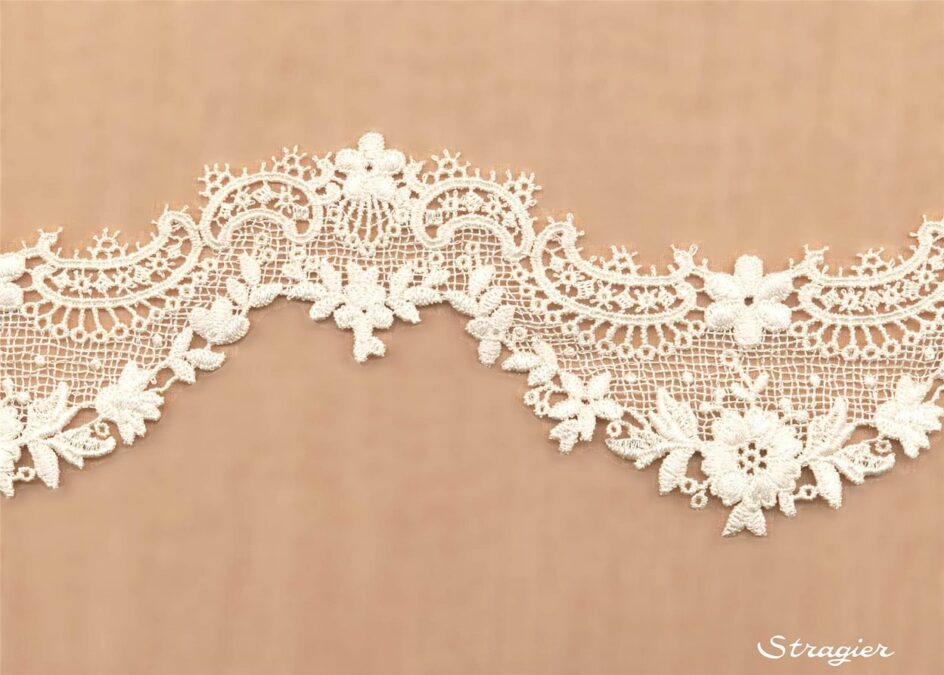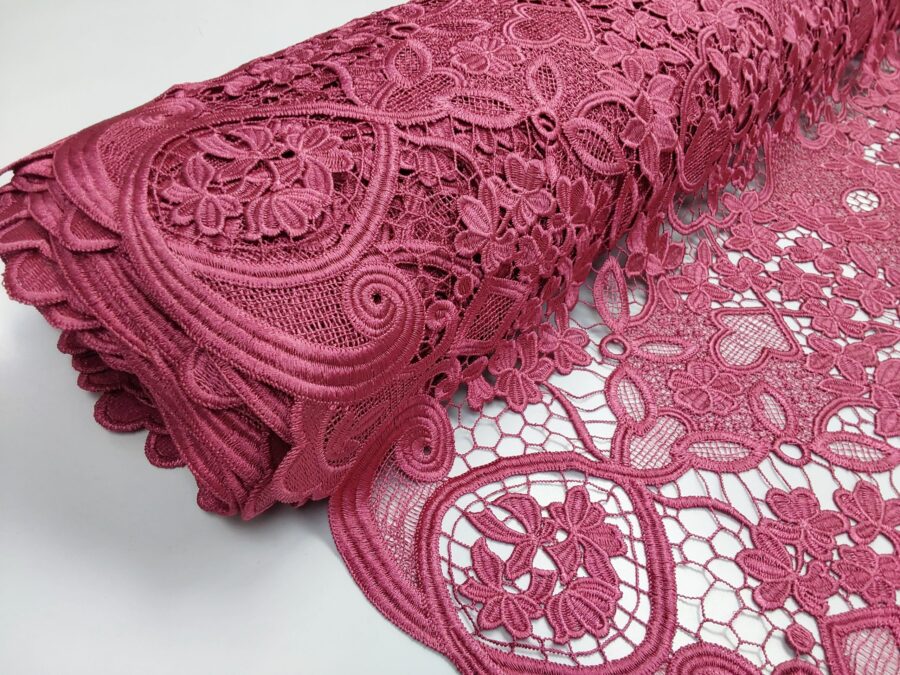Guipure lace, with its intricate patterns and luxurious feel, has long been a favorite among designers, brides, and fashion enthusiasts. This unique lace type stands out for its bold motifs and lack of a net background, making it a versatile and elegant choice for a variety of applications. In this article, we’ll explore the history, characteristics, uses, care tips, and styling ideas for guipure lace, as well as why it remains a top choice in the world of textiles.
What is Guipure Lace?
Guipure lace is a type of lace that is characterized by its heavy, raised motifs connected by bars or plaits rather than a net or mesh background. Unlike other laces, such as Chantilly or Alençon, guipure lace does not have a tulle or mesh base. Instead, the motifs are connected by threads, creating a bold, open design that is both sturdy and visually striking.
The name “guipure” comes from the French word for “gimp,” which refers to the thicker threads used to outline the motifs. This lace is often made from cotton, polyester, or a blend of fibers, and is known for its durability and versatility.
A Brief History of Guipure Lace
Guipure lace has its origins in 16th-century Europe, particularly in France and Italy. It was initially made by hand, using a technique called bobbin lace-making. Over time, the process evolved, and machine-made guipure lace became popular in the 19th century, making it more accessible and affordable.
Historically, guipure lace was used for ecclesiastical garments, royal attire, and high-fashion clothing. Its bold patterns and luxurious appearance made it a symbol of wealth and sophistication. Today, guipure lace continues to be a staple in bridal wear, evening gowns, and even everyday fashion.
Key Characteristics of Guipure Lace

Guipure lace is easily recognizable by several distinct features:
- No Net Background: Unlike many other laces, guipure lace motifs are connected by bars or plaits, not a mesh or tulle.
- Bold, Raised Motifs: The patterns are often floral, geometric, or abstract, and are outlined with thicker threads for a three-dimensional effect.
- Durability: The lack of a delicate net makes guipure lace more robust and less prone to tearing.
- Versatility: Available in a wide range of colors, patterns, and widths, guipure lace can be used for everything from clothing to home décor.
Popular Uses of Guipure Lace
Guipure lace’s unique structure and visual appeal make it a favorite for a variety of applications:
1. Bridal Wear
Guipure lace is a top choice for wedding dresses, veils, and accessories. Its bold patterns add texture and elegance to bridal gowns, making them stand out. Many brides opt for guipure lace sleeves, bodices, or overlays for a romantic and timeless look.
2. Evening and Cocktail Dresses
Designers often use guipure lace to create stunning evening and cocktail dresses. The lace’s structure allows for dramatic silhouettes and eye-catching details, perfect for special occasions.
3. Everyday Fashion
Guipure lace is not limited to formal wear. It is commonly used in blouses, skirts, and even casual dresses. Its durability makes it suitable for everyday use, while its intricate patterns add a touch of sophistication to any outfit.
4. Accessories
From lace collars and cuffs to handbags and shoes, guipure lace is a popular choice for accessories. Its bold motifs can transform simple items into statement pieces.
5. Home Décor
Guipure lace is also used in home décor, including tablecloths, curtains, and pillow covers. Its elegant patterns can elevate the look of any room, adding a touch of vintage charm or modern sophistication.
How to Care for Guipure Lace
Proper care is essential to maintain the beauty and longevity of guipure lace. Here are some tips:
- Hand Wash: Whenever possible, hand wash guipure lace items in cold water with a mild detergent. Avoid wringing or twisting the fabric.
- Machine Wash: If machine washing is necessary, use a gentle cycle and place the lace item in a mesh laundry bag to prevent snagging.
- Drying: Lay the lace flat to dry, away from direct sunlight. Avoid using a dryer, as the heat can damage the fibers.
- Ironing: If ironing is needed, use a low heat setting and place a cloth between the iron and the lace to prevent scorching.
- Storage: Store guipure lace items flat or rolled, rather than folded, to avoid creases and maintain their shape.
Styling Tips for Guipure Lace
Guipure lace is incredibly versatile and can be styled in numerous ways:
- Mix Textures: Pair guipure lace with denim, leather, or silk for a modern, fashion-forward look.
- Layering: Use guipure lace as an overlay on dresses or tops for added dimension and interest.
- Accessorize: Add guipure lace accessories, such as collars or cuffs, to update and elevate basic outfits.
- Color Play: While white and ivory are classic choices, don’t be afraid to experiment with bold colors for a contemporary twist.
Why Choose Guipure Lace?
There are several reasons why guipure lace remains a favorite among designers and consumers:
- Timeless Elegance: Its classic patterns and luxurious feel never go out of style.
- Versatility: Suitable for both formal and casual wear, as well as home décor.
- Durability: More robust than many other lace types, making it a practical choice.
- Unique Designs: The openwork structure allows for creative and bold patterns that stand out.
Guipure Lace in Modern Fashion
In recent years, guipure lace has seen a resurgence in popularity, thanks to its use by top fashion designers and its presence on runways around the world. From bohemian-inspired festival wear to high-fashion couture, guipure lace continues to inspire and captivate.
Celebrities and influencers often choose guipure lace for red carpet events, further cementing its status as a symbol of elegance and sophistication. Its adaptability means it can be styled for any season, making it a year-round favorite.
Where to Buy Guipure Lace
Guipure lace is widely available at fabric stores, both online and offline. When purchasing guipure lace, consider the following:
- Quality: Look for well-defined motifs and sturdy connections between patterns.
- Fiber Content: Cotton guipure lace is soft and breathable, while polyester blends offer added durability.
- Color and Pattern: Choose a color and pattern that suits your project and personal style.
Popular online retailers such as Etsy, Amazon, and specialized fabric stores offer a wide selection of guipure lace in various colors, widths, and designs.
Conclusion
Guipure lace is a timeless textile that combines beauty, durability, and versatility. Whether you’re a bride searching for the perfect wedding dress, a designer looking for inspiration, or a DIY enthusiast planning your next project, guipure lace offers endless possibilities. Its bold patterns and luxurious feel make it a standout choice for fashion and home décor alike.
By understanding the history, characteristics, and care of guipure lace, you can make the most of this exquisite fabric and incorporate its elegance into your wardrobe or living space. Explore the world of guipure lace and discover why it remains a beloved classic in the world of textiles.



